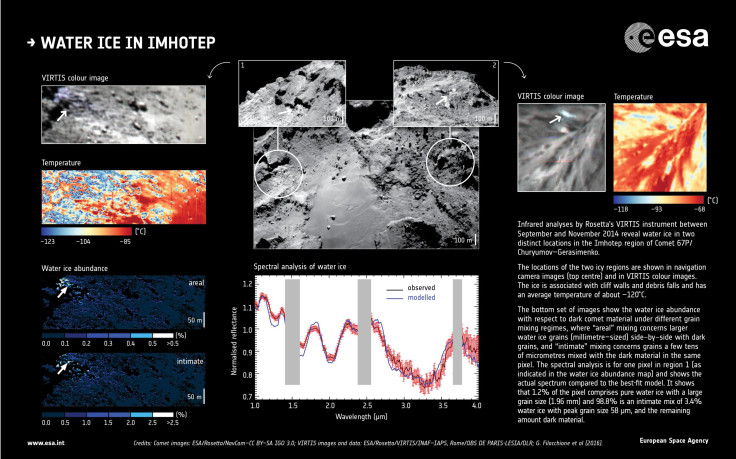Rosetta Spacecraft Finds Ice On The Surface Of Comet 67P

The Rosetta spacecraft has detected frozen water on the surface of comet 67P/Churyumov–Gerasimenko, the European Space Agency confirmed Wednesday. Rosetta first observed large patches of ice in different regions of the comet. The ice may have been exposed after a cliff or debris fell away from the area.
Researchers from the National Institute for Astrophysics in Rome used data collected by Rosetta's VIRTIS infrared instrument to determine the composition of exposed ice in the region of the comet known as Imhotep. Ice was previously detected on comet 67P by Rosetta, but the structure of ice found in Imhotep was very different from that found in the Hapi region — located near the "neck" that connects the two lobes of the comet.
In Hapi, the ice grains were much smaller than those found in Imhotep. These grains may have been formed during the daily ice cycle of the comet. Ice could heat up as the comet rotates. The condensation formed when the comet was warmer and could turn to frost when not exposed to sunlight.

The difference in sizes between ice grains indicates different ways ice can form in the comet. "The various populations of icy grains on the surface of the comet imply different formation mechanisms, and different time scales for their formation," Gianrico Filacchione, VIRTIS deputy principal investigator from the National Institute for Astrophysics, said in a statement.
The ice in Imhotep may have formed secondarily by either getting stuck together — known as sintering — or escaping water vapor from underneath the comet's surface. Sunlight could heat up ice underneath the surface comet 67p, causing some of the water vapor to escape, but some water could get trapped and freeze on the comet's surface in a process known as sublimation.
Further testing in a lab determined 80 percent of water vapor does not escape the comet. The research, published in the journal Nature, indicates the features of comet 67p evolve over time instead of its global composition being determined during its formation.
Ice was first detected on comet 67p by Rosetta's onboard camera in September 2014. Ice was detected in Imhotep, Hatmehit, Khepry, Hapi and Anuket. The Microwave Instrument for Rosetta Orbiter (MIRO), developed by NASA, detected water vapor from comet 67p escaping into space at the rate of 1.2 liters every second at the end of August 2014.
© Copyright IBTimes 2024. All rights reserved.






















